Analysis of Australia's Economic Performance: Q1 2016-Q2 2017
VerifiedAdded on 2020/02/19
|12
|2565
|39
Report
AI Summary
This report offers a comprehensive analysis of Australia's economic performance, focusing on key macroeconomic indicators such as GDP growth, inflation, unemployment, and terms of trade. It examines the role of the Reserve Bank of Australia (RBA) in managing the economy through monetary and fiscal policies, including interest rate adjustments and inflation targets. The report compares the economic conditions between Q2 2016 and Q1 2017, highlighting improvements in the latter period. It also identifies and discusses three major challenges facing the Australian economy over the next 12 months: the aging population, the existing tax system, and infrastructure and capital investment. The analysis underscores the importance of these factors in influencing the nation's economic health and future growth prospects. The report concludes by summarizing the key findings and forecasting potential economic trends.
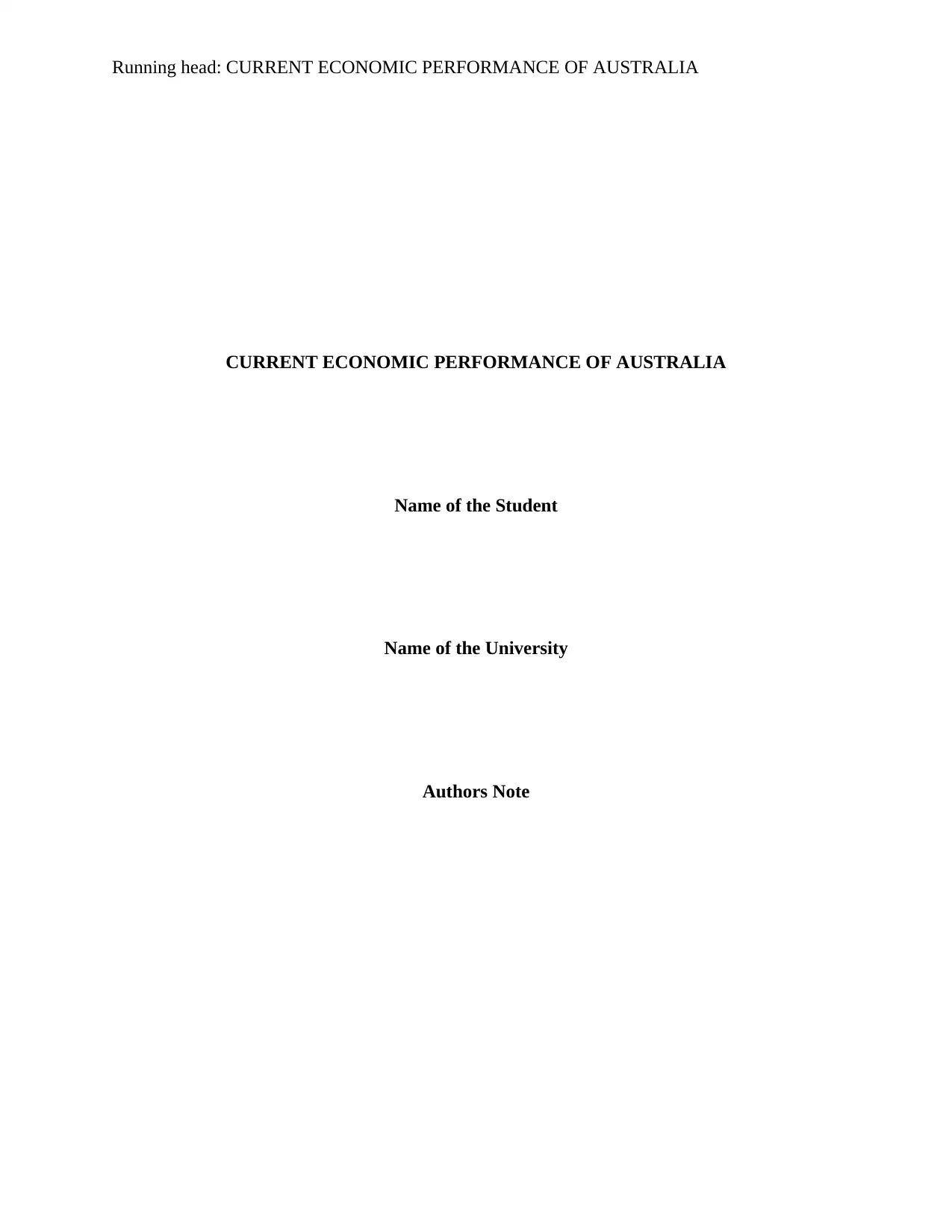
Running head: CURRENT ECONOMIC PERFORMANCE OF AUSTRALIA
CURRENT ECONOMIC PERFORMANCE OF AUSTRALIA
Name of the Student
Name of the University
Authors Note
CURRENT ECONOMIC PERFORMANCE OF AUSTRALIA
Name of the Student
Name of the University
Authors Note
Paraphrase This Document
Need a fresh take? Get an instant paraphrase of this document with our AI Paraphraser
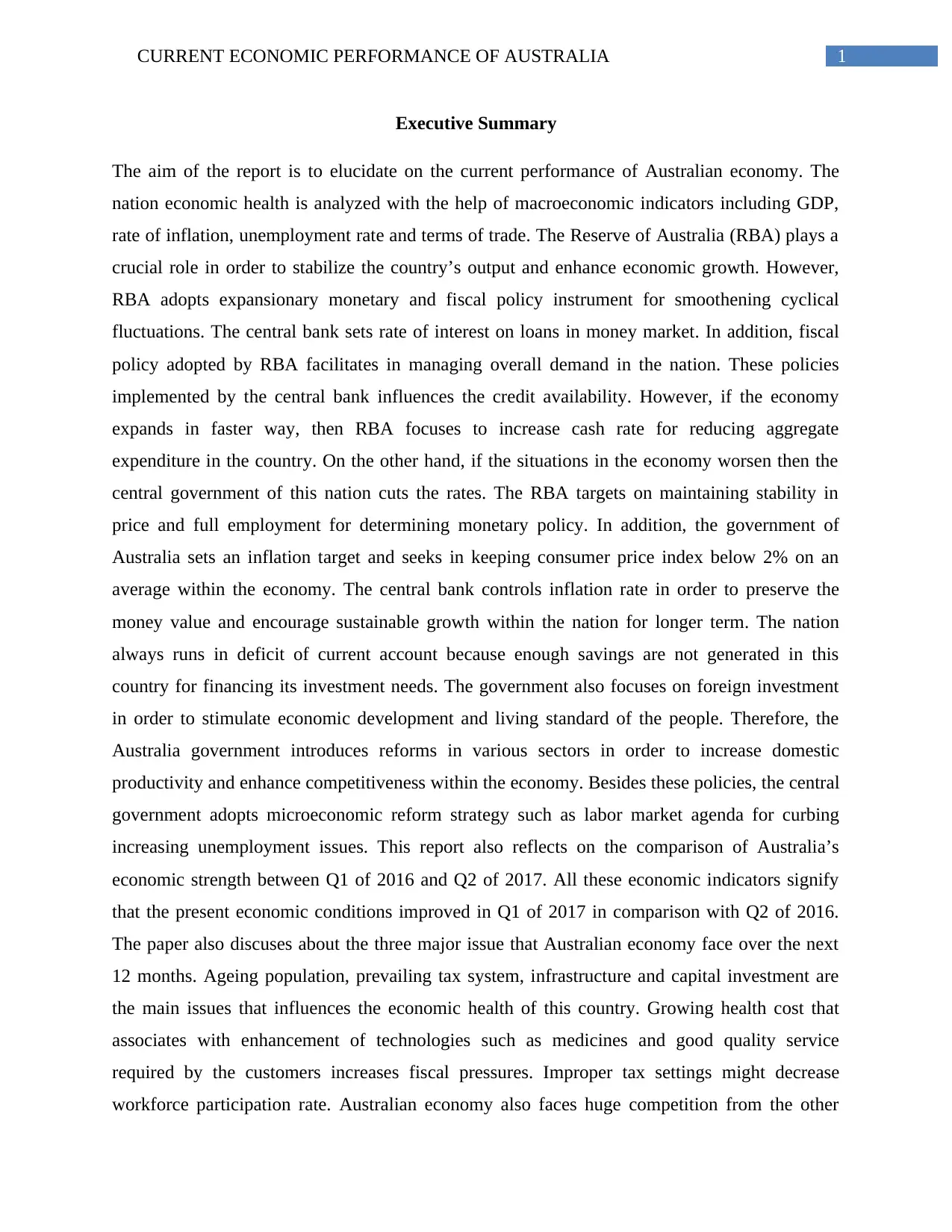
1CURRENT ECONOMIC PERFORMANCE OF AUSTRALIA
Executive Summary
The aim of the report is to elucidate on the current performance of Australian economy. The
nation economic health is analyzed with the help of macroeconomic indicators including GDP,
rate of inflation, unemployment rate and terms of trade. The Reserve of Australia (RBA) plays a
crucial role in order to stabilize the country’s output and enhance economic growth. However,
RBA adopts expansionary monetary and fiscal policy instrument for smoothening cyclical
fluctuations. The central bank sets rate of interest on loans in money market. In addition, fiscal
policy adopted by RBA facilitates in managing overall demand in the nation. These policies
implemented by the central bank influences the credit availability. However, if the economy
expands in faster way, then RBA focuses to increase cash rate for reducing aggregate
expenditure in the country. On the other hand, if the situations in the economy worsen then the
central government of this nation cuts the rates. The RBA targets on maintaining stability in
price and full employment for determining monetary policy. In addition, the government of
Australia sets an inflation target and seeks in keeping consumer price index below 2% on an
average within the economy. The central bank controls inflation rate in order to preserve the
money value and encourage sustainable growth within the nation for longer term. The nation
always runs in deficit of current account because enough savings are not generated in this
country for financing its investment needs. The government also focuses on foreign investment
in order to stimulate economic development and living standard of the people. Therefore, the
Australia government introduces reforms in various sectors in order to increase domestic
productivity and enhance competitiveness within the economy. Besides these policies, the central
government adopts microeconomic reform strategy such as labor market agenda for curbing
increasing unemployment issues. This report also reflects on the comparison of Australia’s
economic strength between Q1 of 2016 and Q2 of 2017. All these economic indicators signify
that the present economic conditions improved in Q1 of 2017 in comparison with Q2 of 2016.
The paper also discuses about the three major issue that Australian economy face over the next
12 months. Ageing population, prevailing tax system, infrastructure and capital investment are
the main issues that influences the economic health of this country. Growing health cost that
associates with enhancement of technologies such as medicines and good quality service
required by the customers increases fiscal pressures. Improper tax settings might decrease
workforce participation rate. Australian economy also faces huge competition from the other
Executive Summary
The aim of the report is to elucidate on the current performance of Australian economy. The
nation economic health is analyzed with the help of macroeconomic indicators including GDP,
rate of inflation, unemployment rate and terms of trade. The Reserve of Australia (RBA) plays a
crucial role in order to stabilize the country’s output and enhance economic growth. However,
RBA adopts expansionary monetary and fiscal policy instrument for smoothening cyclical
fluctuations. The central bank sets rate of interest on loans in money market. In addition, fiscal
policy adopted by RBA facilitates in managing overall demand in the nation. These policies
implemented by the central bank influences the credit availability. However, if the economy
expands in faster way, then RBA focuses to increase cash rate for reducing aggregate
expenditure in the country. On the other hand, if the situations in the economy worsen then the
central government of this nation cuts the rates. The RBA targets on maintaining stability in
price and full employment for determining monetary policy. In addition, the government of
Australia sets an inflation target and seeks in keeping consumer price index below 2% on an
average within the economy. The central bank controls inflation rate in order to preserve the
money value and encourage sustainable growth within the nation for longer term. The nation
always runs in deficit of current account because enough savings are not generated in this
country for financing its investment needs. The government also focuses on foreign investment
in order to stimulate economic development and living standard of the people. Therefore, the
Australia government introduces reforms in various sectors in order to increase domestic
productivity and enhance competitiveness within the economy. Besides these policies, the central
government adopts microeconomic reform strategy such as labor market agenda for curbing
increasing unemployment issues. This report also reflects on the comparison of Australia’s
economic strength between Q1 of 2016 and Q2 of 2017. All these economic indicators signify
that the present economic conditions improved in Q1 of 2017 in comparison with Q2 of 2016.
The paper also discuses about the three major issue that Australian economy face over the next
12 months. Ageing population, prevailing tax system, infrastructure and capital investment are
the main issues that influences the economic health of this country. Growing health cost that
associates with enhancement of technologies such as medicines and good quality service
required by the customers increases fiscal pressures. Improper tax settings might decrease
workforce participation rate. Australian economy also faces huge competition from the other
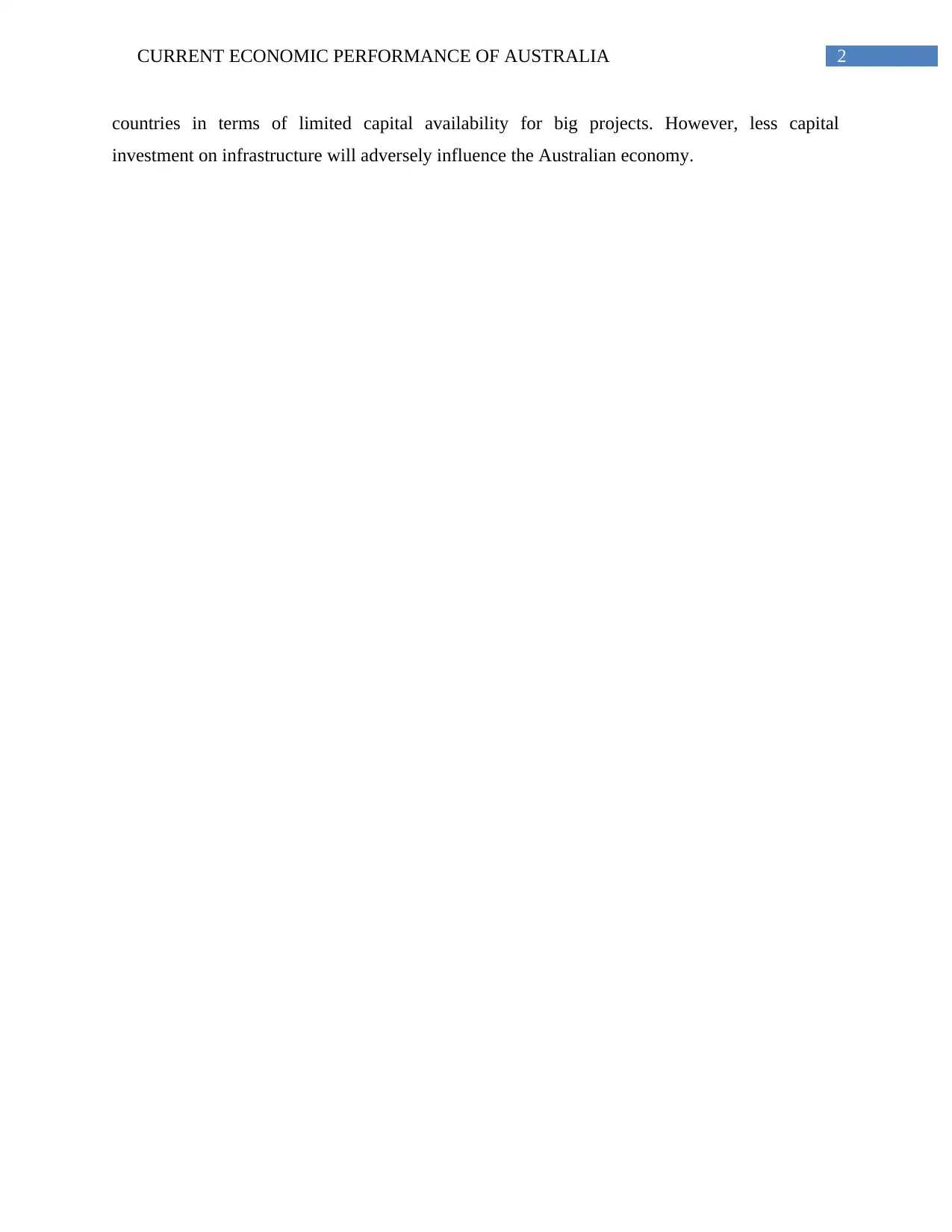
2CURRENT ECONOMIC PERFORMANCE OF AUSTRALIA
countries in terms of limited capital availability for big projects. However, less capital
investment on infrastructure will adversely influence the Australian economy.
countries in terms of limited capital availability for big projects. However, less capital
investment on infrastructure will adversely influence the Australian economy.
⊘ This is a preview!⊘
Do you want full access?
Subscribe today to unlock all pages.

Trusted by 1+ million students worldwide
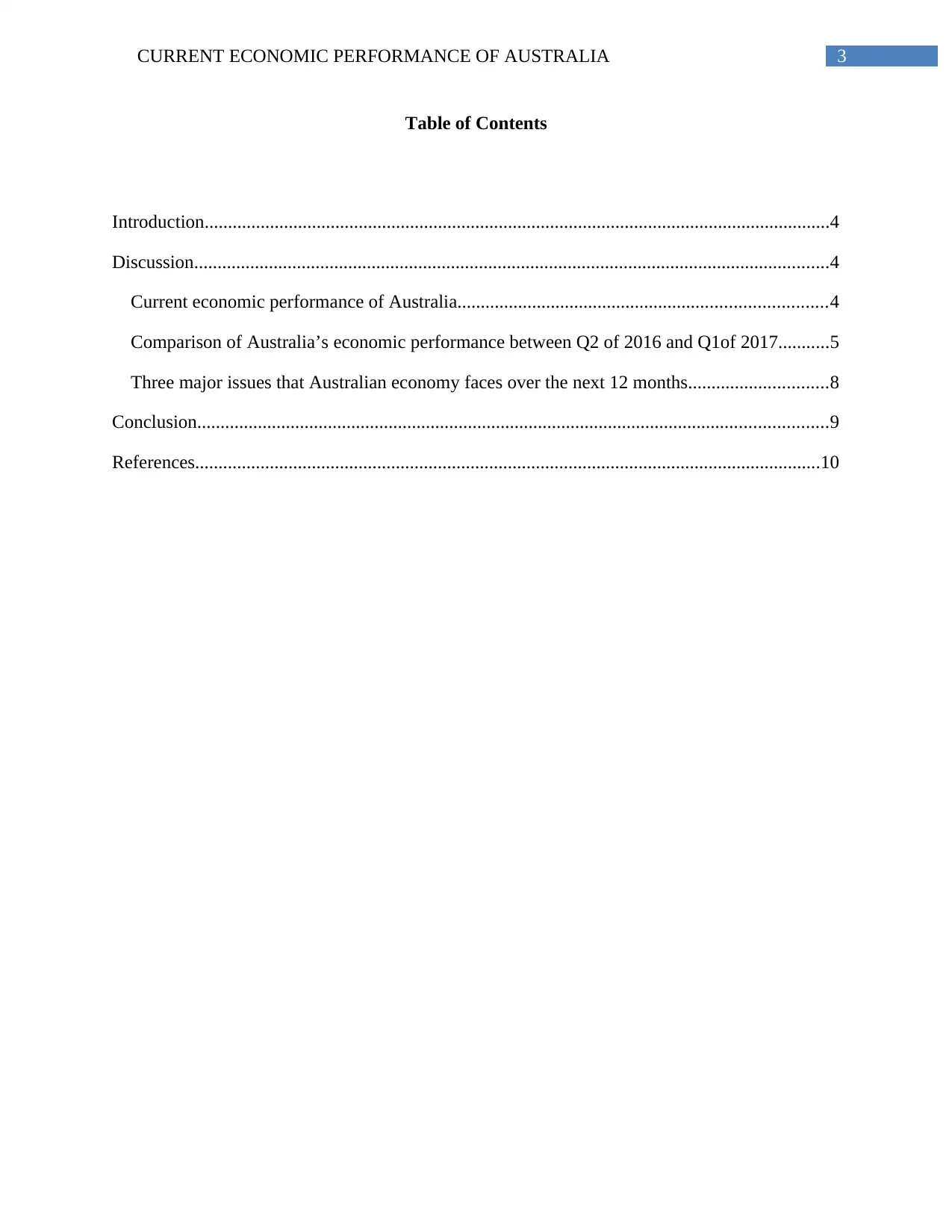
3CURRENT ECONOMIC PERFORMANCE OF AUSTRALIA
Table of Contents
Introduction......................................................................................................................................4
Discussion........................................................................................................................................4
Current economic performance of Australia...............................................................................4
Comparison of Australia’s economic performance between Q2 of 2016 and Q1of 2017...........5
Three major issues that Australian economy faces over the next 12 months..............................8
Conclusion.......................................................................................................................................9
References......................................................................................................................................10
Table of Contents
Introduction......................................................................................................................................4
Discussion........................................................................................................................................4
Current economic performance of Australia...............................................................................4
Comparison of Australia’s economic performance between Q2 of 2016 and Q1of 2017...........5
Three major issues that Australian economy faces over the next 12 months..............................8
Conclusion.......................................................................................................................................9
References......................................................................................................................................10
Paraphrase This Document
Need a fresh take? Get an instant paraphrase of this document with our AI Paraphraser
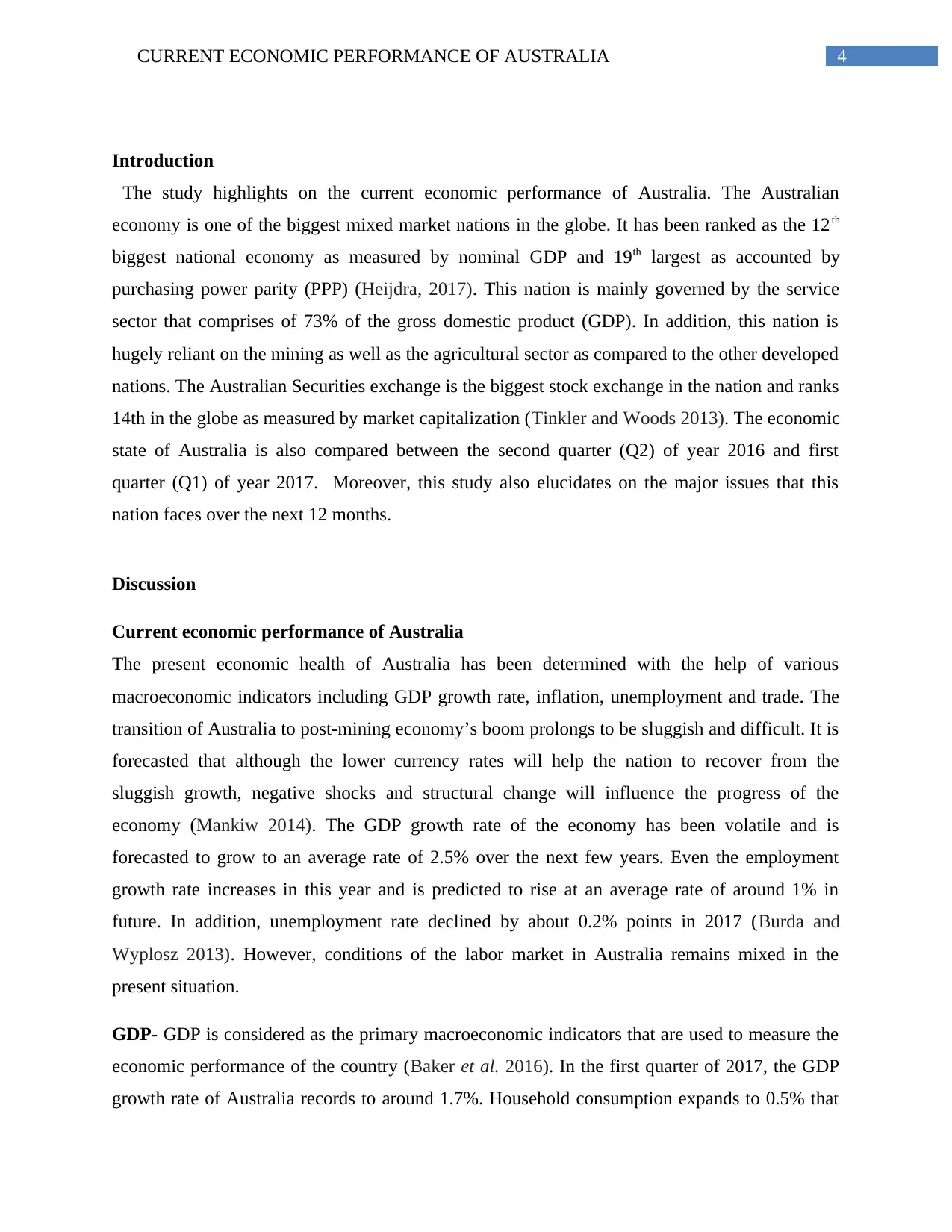
4CURRENT ECONOMIC PERFORMANCE OF AUSTRALIA
Introduction
The study highlights on the current economic performance of Australia. The Australian
economy is one of the biggest mixed market nations in the globe. It has been ranked as the 12th
biggest national economy as measured by nominal GDP and 19th largest as accounted by
purchasing power parity (PPP) (Heijdra, 2017). This nation is mainly governed by the service
sector that comprises of 73% of the gross domestic product (GDP). In addition, this nation is
hugely reliant on the mining as well as the agricultural sector as compared to the other developed
nations. The Australian Securities exchange is the biggest stock exchange in the nation and ranks
14th in the globe as measured by market capitalization (Tinkler and Woods 2013). The economic
state of Australia is also compared between the second quarter (Q2) of year 2016 and first
quarter (Q1) of year 2017. Moreover, this study also elucidates on the major issues that this
nation faces over the next 12 months.
Discussion
Current economic performance of Australia
The present economic health of Australia has been determined with the help of various
macroeconomic indicators including GDP growth rate, inflation, unemployment and trade. The
transition of Australia to post-mining economy’s boom prolongs to be sluggish and difficult. It is
forecasted that although the lower currency rates will help the nation to recover from the
sluggish growth, negative shocks and structural change will influence the progress of the
economy (Mankiw 2014). The GDP growth rate of the economy has been volatile and is
forecasted to grow to an average rate of 2.5% over the next few years. Even the employment
growth rate increases in this year and is predicted to rise at an average rate of around 1% in
future. In addition, unemployment rate declined by about 0.2% points in 2017 (Burda and
Wyplosz 2013). However, conditions of the labor market in Australia remains mixed in the
present situation.
GDP- GDP is considered as the primary macroeconomic indicators that are used to measure the
economic performance of the country (Baker et al. 2016). In the first quarter of 2017, the GDP
growth rate of Australia records to around 1.7%. Household consumption expands to 0.5% that
Introduction
The study highlights on the current economic performance of Australia. The Australian
economy is one of the biggest mixed market nations in the globe. It has been ranked as the 12th
biggest national economy as measured by nominal GDP and 19th largest as accounted by
purchasing power parity (PPP) (Heijdra, 2017). This nation is mainly governed by the service
sector that comprises of 73% of the gross domestic product (GDP). In addition, this nation is
hugely reliant on the mining as well as the agricultural sector as compared to the other developed
nations. The Australian Securities exchange is the biggest stock exchange in the nation and ranks
14th in the globe as measured by market capitalization (Tinkler and Woods 2013). The economic
state of Australia is also compared between the second quarter (Q2) of year 2016 and first
quarter (Q1) of year 2017. Moreover, this study also elucidates on the major issues that this
nation faces over the next 12 months.
Discussion
Current economic performance of Australia
The present economic health of Australia has been determined with the help of various
macroeconomic indicators including GDP growth rate, inflation, unemployment and trade. The
transition of Australia to post-mining economy’s boom prolongs to be sluggish and difficult. It is
forecasted that although the lower currency rates will help the nation to recover from the
sluggish growth, negative shocks and structural change will influence the progress of the
economy (Mankiw 2014). The GDP growth rate of the economy has been volatile and is
forecasted to grow to an average rate of 2.5% over the next few years. Even the employment
growth rate increases in this year and is predicted to rise at an average rate of around 1% in
future. In addition, unemployment rate declined by about 0.2% points in 2017 (Burda and
Wyplosz 2013). However, conditions of the labor market in Australia remains mixed in the
present situation.
GDP- GDP is considered as the primary macroeconomic indicators that are used to measure the
economic performance of the country (Baker et al. 2016). In the first quarter of 2017, the GDP
growth rate of Australia records to around 1.7%. Household consumption expands to 0.5% that
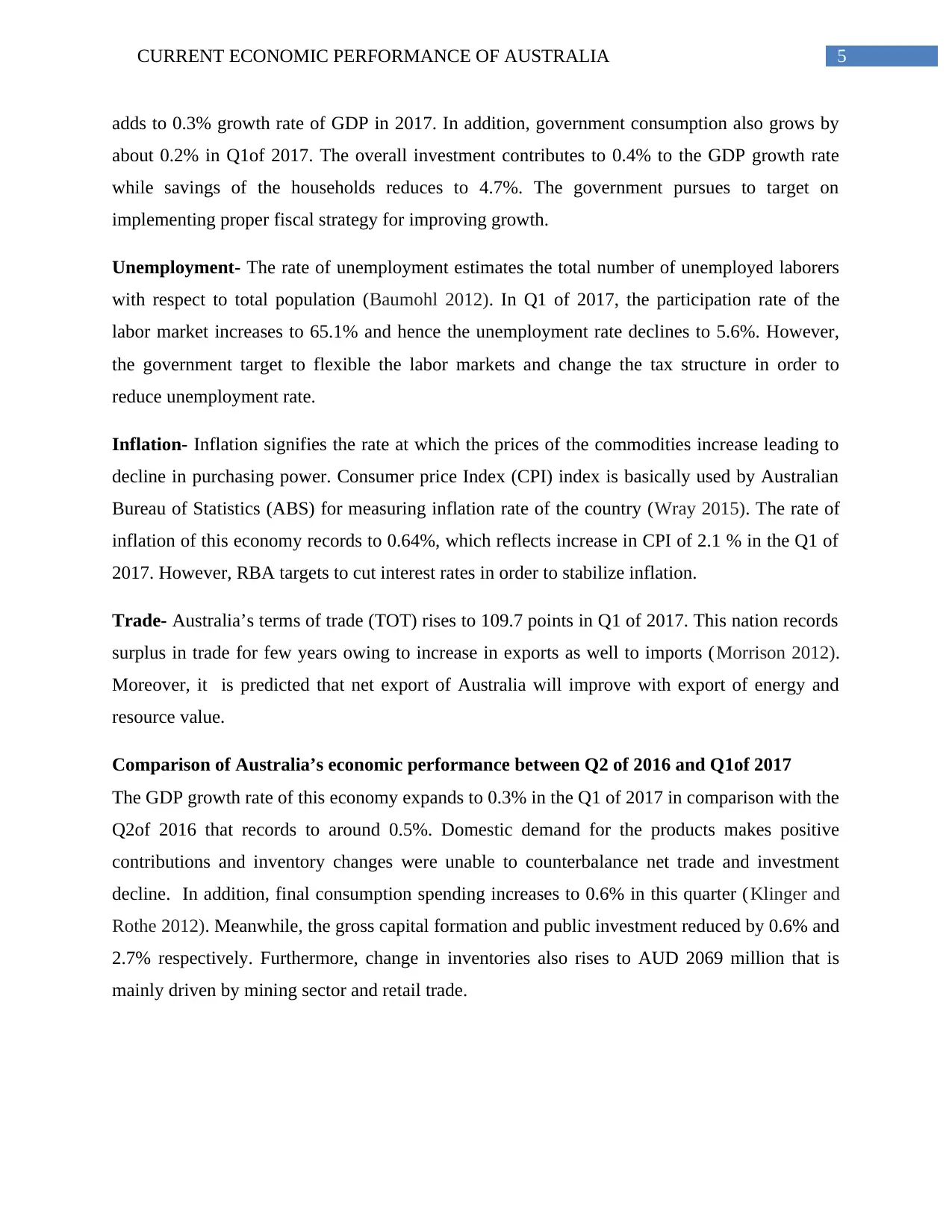
5CURRENT ECONOMIC PERFORMANCE OF AUSTRALIA
adds to 0.3% growth rate of GDP in 2017. In addition, government consumption also grows by
about 0.2% in Q1of 2017. The overall investment contributes to 0.4% to the GDP growth rate
while savings of the households reduces to 4.7%. The government pursues to target on
implementing proper fiscal strategy for improving growth.
Unemployment- The rate of unemployment estimates the total number of unemployed laborers
with respect to total population (Baumohl 2012). In Q1 of 2017, the participation rate of the
labor market increases to 65.1% and hence the unemployment rate declines to 5.6%. However,
the government target to flexible the labor markets and change the tax structure in order to
reduce unemployment rate.
Inflation- Inflation signifies the rate at which the prices of the commodities increase leading to
decline in purchasing power. Consumer price Index (CPI) index is basically used by Australian
Bureau of Statistics (ABS) for measuring inflation rate of the country (Wray 2015). The rate of
inflation of this economy records to 0.64%, which reflects increase in CPI of 2.1 % in the Q1 of
2017. However, RBA targets to cut interest rates in order to stabilize inflation.
Trade- Australia’s terms of trade (TOT) rises to 109.7 points in Q1 of 2017. This nation records
surplus in trade for few years owing to increase in exports as well to imports (Morrison 2012).
Moreover, it is predicted that net export of Australia will improve with export of energy and
resource value.
Comparison of Australia’s economic performance between Q2 of 2016 and Q1of 2017
The GDP growth rate of this economy expands to 0.3% in the Q1 of 2017 in comparison with the
Q2of 2016 that records to around 0.5%. Domestic demand for the products makes positive
contributions and inventory changes were unable to counterbalance net trade and investment
decline. In addition, final consumption spending increases to 0.6% in this quarter (Klinger and
Rothe 2012). Meanwhile, the gross capital formation and public investment reduced by 0.6% and
2.7% respectively. Furthermore, change in inventories also rises to AUD 2069 million that is
mainly driven by mining sector and retail trade.
adds to 0.3% growth rate of GDP in 2017. In addition, government consumption also grows by
about 0.2% in Q1of 2017. The overall investment contributes to 0.4% to the GDP growth rate
while savings of the households reduces to 4.7%. The government pursues to target on
implementing proper fiscal strategy for improving growth.
Unemployment- The rate of unemployment estimates the total number of unemployed laborers
with respect to total population (Baumohl 2012). In Q1 of 2017, the participation rate of the
labor market increases to 65.1% and hence the unemployment rate declines to 5.6%. However,
the government target to flexible the labor markets and change the tax structure in order to
reduce unemployment rate.
Inflation- Inflation signifies the rate at which the prices of the commodities increase leading to
decline in purchasing power. Consumer price Index (CPI) index is basically used by Australian
Bureau of Statistics (ABS) for measuring inflation rate of the country (Wray 2015). The rate of
inflation of this economy records to 0.64%, which reflects increase in CPI of 2.1 % in the Q1 of
2017. However, RBA targets to cut interest rates in order to stabilize inflation.
Trade- Australia’s terms of trade (TOT) rises to 109.7 points in Q1 of 2017. This nation records
surplus in trade for few years owing to increase in exports as well to imports (Morrison 2012).
Moreover, it is predicted that net export of Australia will improve with export of energy and
resource value.
Comparison of Australia’s economic performance between Q2 of 2016 and Q1of 2017
The GDP growth rate of this economy expands to 0.3% in the Q1 of 2017 in comparison with the
Q2of 2016 that records to around 0.5%. Domestic demand for the products makes positive
contributions and inventory changes were unable to counterbalance net trade and investment
decline. In addition, final consumption spending increases to 0.6% in this quarter (Klinger and
Rothe 2012). Meanwhile, the gross capital formation and public investment reduced by 0.6% and
2.7% respectively. Furthermore, change in inventories also rises to AUD 2069 million that is
mainly driven by mining sector and retail trade.
⊘ This is a preview!⊘
Do you want full access?
Subscribe today to unlock all pages.

Trusted by 1+ million students worldwide
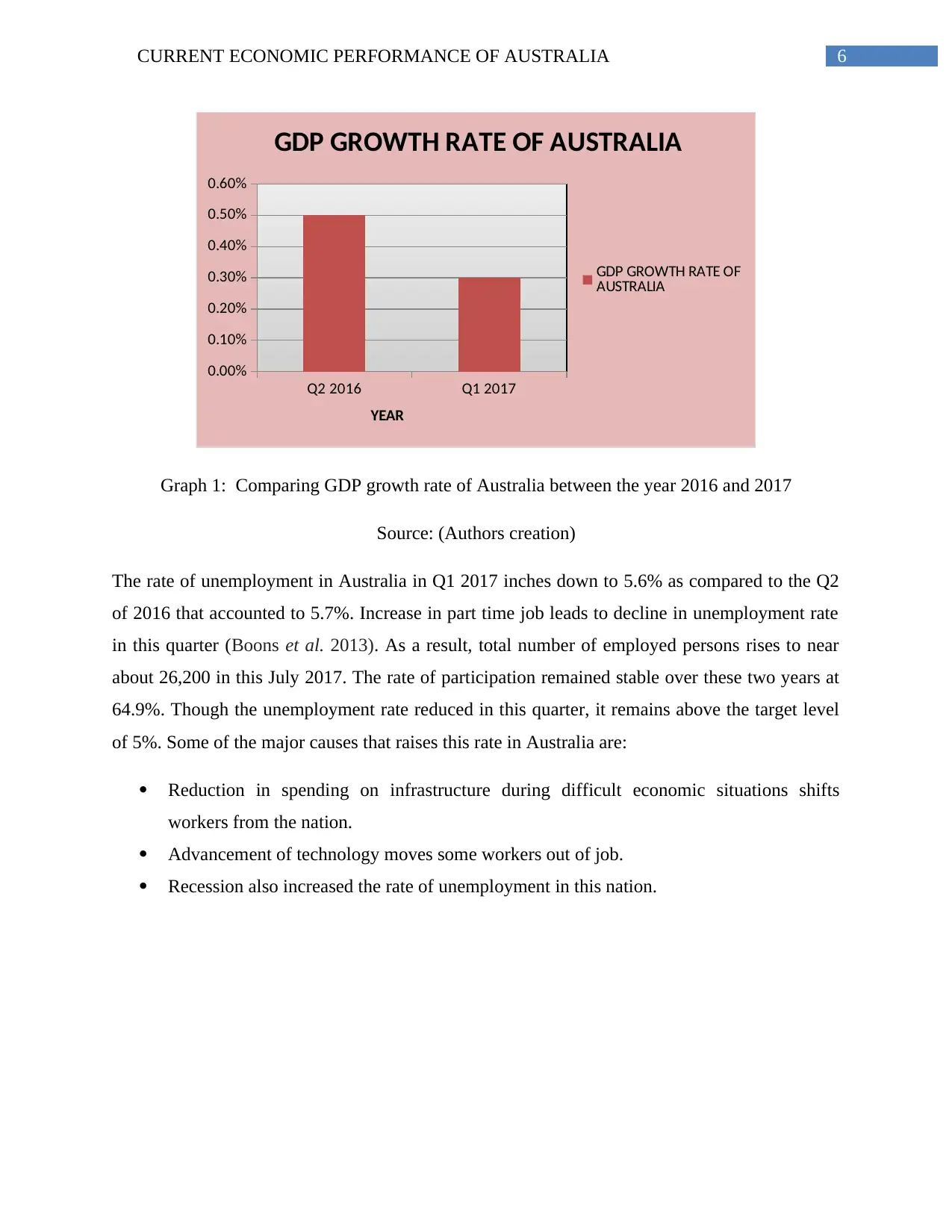
6CURRENT ECONOMIC PERFORMANCE OF AUSTRALIA
Q2 2016 Q1 2017
0.00%
0.10%
0.20%
0.30%
0.40%
0.50%
0.60%
GDP GROWTH RATE OF AUSTRALIA
GDP GROWTH RATE OF
AUSTRALIA
YEAR
Graph 1: Comparing GDP growth rate of Australia between the year 2016 and 2017
Source: (Authors creation)
The rate of unemployment in Australia in Q1 2017 inches down to 5.6% as compared to the Q2
of 2016 that accounted to 5.7%. Increase in part time job leads to decline in unemployment rate
in this quarter (Boons et al. 2013). As a result, total number of employed persons rises to near
about 26,200 in this July 2017. The rate of participation remained stable over these two years at
64.9%. Though the unemployment rate reduced in this quarter, it remains above the target level
of 5%. Some of the major causes that raises this rate in Australia are:
Reduction in spending on infrastructure during difficult economic situations shifts
workers from the nation.
Advancement of technology moves some workers out of job.
Recession also increased the rate of unemployment in this nation.
Q2 2016 Q1 2017
0.00%
0.10%
0.20%
0.30%
0.40%
0.50%
0.60%
GDP GROWTH RATE OF AUSTRALIA
GDP GROWTH RATE OF
AUSTRALIA
YEAR
Graph 1: Comparing GDP growth rate of Australia between the year 2016 and 2017
Source: (Authors creation)
The rate of unemployment in Australia in Q1 2017 inches down to 5.6% as compared to the Q2
of 2016 that accounted to 5.7%. Increase in part time job leads to decline in unemployment rate
in this quarter (Boons et al. 2013). As a result, total number of employed persons rises to near
about 26,200 in this July 2017. The rate of participation remained stable over these two years at
64.9%. Though the unemployment rate reduced in this quarter, it remains above the target level
of 5%. Some of the major causes that raises this rate in Australia are:
Reduction in spending on infrastructure during difficult economic situations shifts
workers from the nation.
Advancement of technology moves some workers out of job.
Recession also increased the rate of unemployment in this nation.
Paraphrase This Document
Need a fresh take? Get an instant paraphrase of this document with our AI Paraphraser
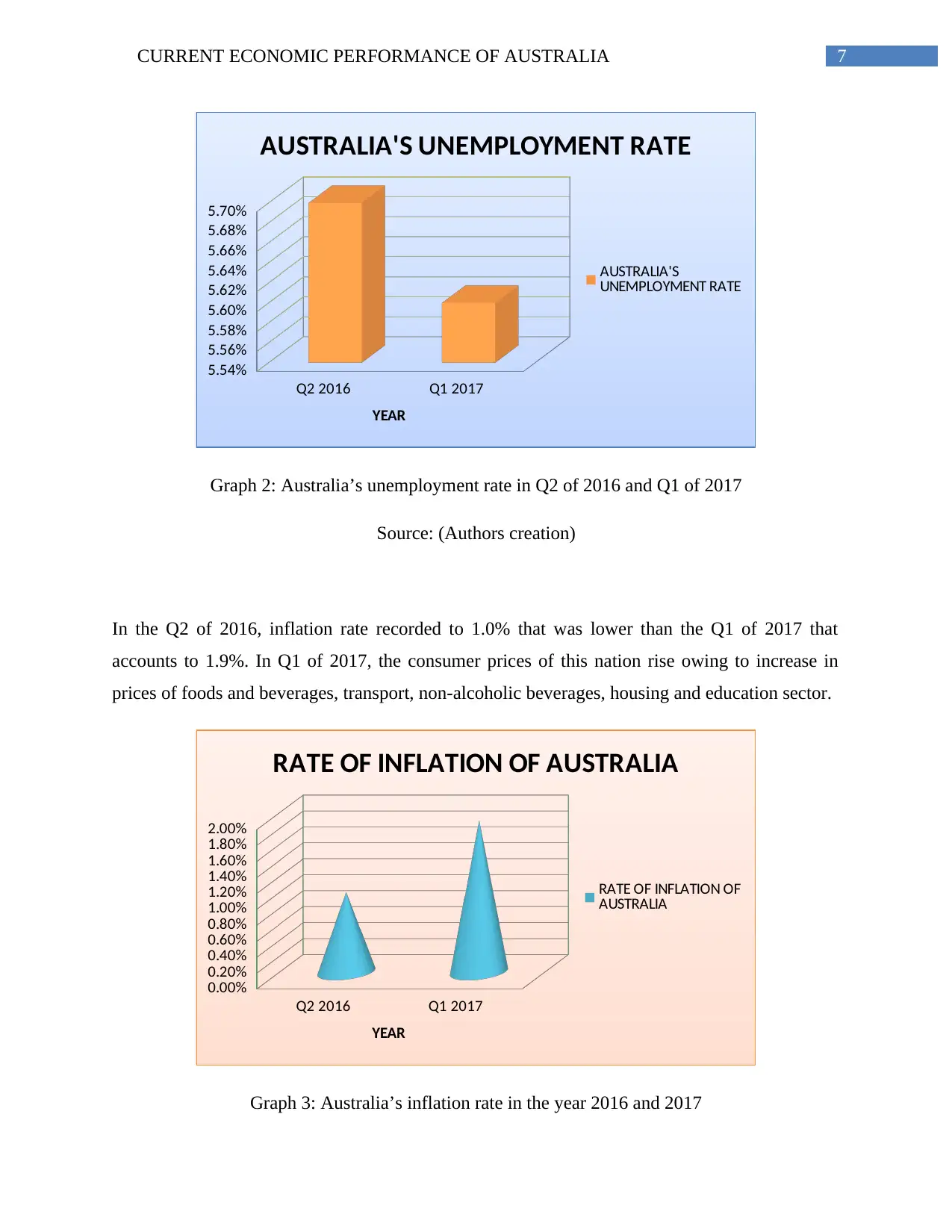
7CURRENT ECONOMIC PERFORMANCE OF AUSTRALIA
Q2 2016 Q1 2017
5.54%
5.56%
5.58%
5.60%
5.62%
5.64%
5.66%
5.68%
5.70%
AUSTRALIA'S UNEMPLOYMENT RATE
AUSTRALIA'S
UNEMPLOYMENT RATE
YEAR
Graph 2: Australia’s unemployment rate in Q2 of 2016 and Q1 of 2017
Source: (Authors creation)
In the Q2 of 2016, inflation rate recorded to 1.0% that was lower than the Q1 of 2017 that
accounts to 1.9%. In Q1 of 2017, the consumer prices of this nation rise owing to increase in
prices of foods and beverages, transport, non-alcoholic beverages, housing and education sector.
Q2 2016 Q1 2017
0.00%
0.20%
0.40%
0.60%
0.80%
1.00%
1.20%
1.40%
1.60%
1.80%
2.00%
RATE OF INFLATION OF AUSTRALIA
RATE OF INFLATION OF
AUSTRALIA
YEAR
Graph 3: Australia’s inflation rate in the year 2016 and 2017
Q2 2016 Q1 2017
5.54%
5.56%
5.58%
5.60%
5.62%
5.64%
5.66%
5.68%
5.70%
AUSTRALIA'S UNEMPLOYMENT RATE
AUSTRALIA'S
UNEMPLOYMENT RATE
YEAR
Graph 2: Australia’s unemployment rate in Q2 of 2016 and Q1 of 2017
Source: (Authors creation)
In the Q2 of 2016, inflation rate recorded to 1.0% that was lower than the Q1 of 2017 that
accounts to 1.9%. In Q1 of 2017, the consumer prices of this nation rise owing to increase in
prices of foods and beverages, transport, non-alcoholic beverages, housing and education sector.
Q2 2016 Q1 2017
0.00%
0.20%
0.40%
0.60%
0.80%
1.00%
1.20%
1.40%
1.60%
1.80%
2.00%
RATE OF INFLATION OF AUSTRALIA
RATE OF INFLATION OF
AUSTRALIA
YEAR
Graph 3: Australia’s inflation rate in the year 2016 and 2017
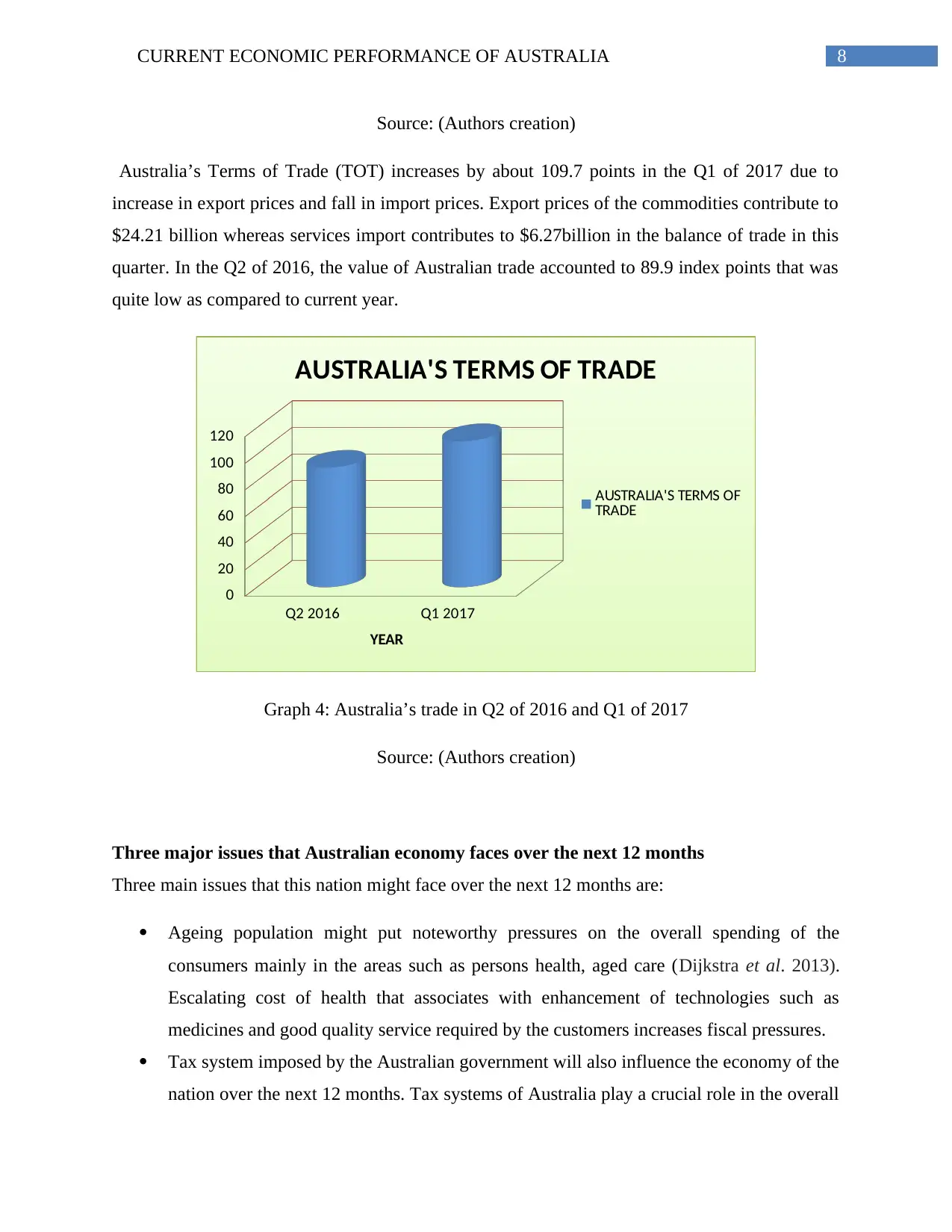
8CURRENT ECONOMIC PERFORMANCE OF AUSTRALIA
Source: (Authors creation)
Australia’s Terms of Trade (TOT) increases by about 109.7 points in the Q1 of 2017 due to
increase in export prices and fall in import prices. Export prices of the commodities contribute to
$24.21 billion whereas services import contributes to $6.27billion in the balance of trade in this
quarter. In the Q2 of 2016, the value of Australian trade accounted to 89.9 index points that was
quite low as compared to current year.
Q2 2016 Q1 2017
0
20
40
60
80
100
120
AUSTRALIA'S TERMS OF TRADE
AUSTRALIA'S TERMS OF
TRADE
YEAR
Graph 4: Australia’s trade in Q2 of 2016 and Q1 of 2017
Source: (Authors creation)
Three major issues that Australian economy faces over the next 12 months
Three main issues that this nation might face over the next 12 months are:
Ageing population might put noteworthy pressures on the overall spending of the
consumers mainly in the areas such as persons health, aged care (Dijkstra et al. 2013).
Escalating cost of health that associates with enhancement of technologies such as
medicines and good quality service required by the customers increases fiscal pressures.
Tax system imposed by the Australian government will also influence the economy of the
nation over the next 12 months. Tax systems of Australia play a crucial role in the overall
Source: (Authors creation)
Australia’s Terms of Trade (TOT) increases by about 109.7 points in the Q1 of 2017 due to
increase in export prices and fall in import prices. Export prices of the commodities contribute to
$24.21 billion whereas services import contributes to $6.27billion in the balance of trade in this
quarter. In the Q2 of 2016, the value of Australian trade accounted to 89.9 index points that was
quite low as compared to current year.
Q2 2016 Q1 2017
0
20
40
60
80
100
120
AUSTRALIA'S TERMS OF TRADE
AUSTRALIA'S TERMS OF
TRADE
YEAR
Graph 4: Australia’s trade in Q2 of 2016 and Q1 of 2017
Source: (Authors creation)
Three major issues that Australian economy faces over the next 12 months
Three main issues that this nation might face over the next 12 months are:
Ageing population might put noteworthy pressures on the overall spending of the
consumers mainly in the areas such as persons health, aged care (Dijkstra et al. 2013).
Escalating cost of health that associates with enhancement of technologies such as
medicines and good quality service required by the customers increases fiscal pressures.
Tax system imposed by the Australian government will also influence the economy of the
nation over the next 12 months. Tax systems of Australia play a crucial role in the overall
⊘ This is a preview!⊘
Do you want full access?
Subscribe today to unlock all pages.

Trusted by 1+ million students worldwide
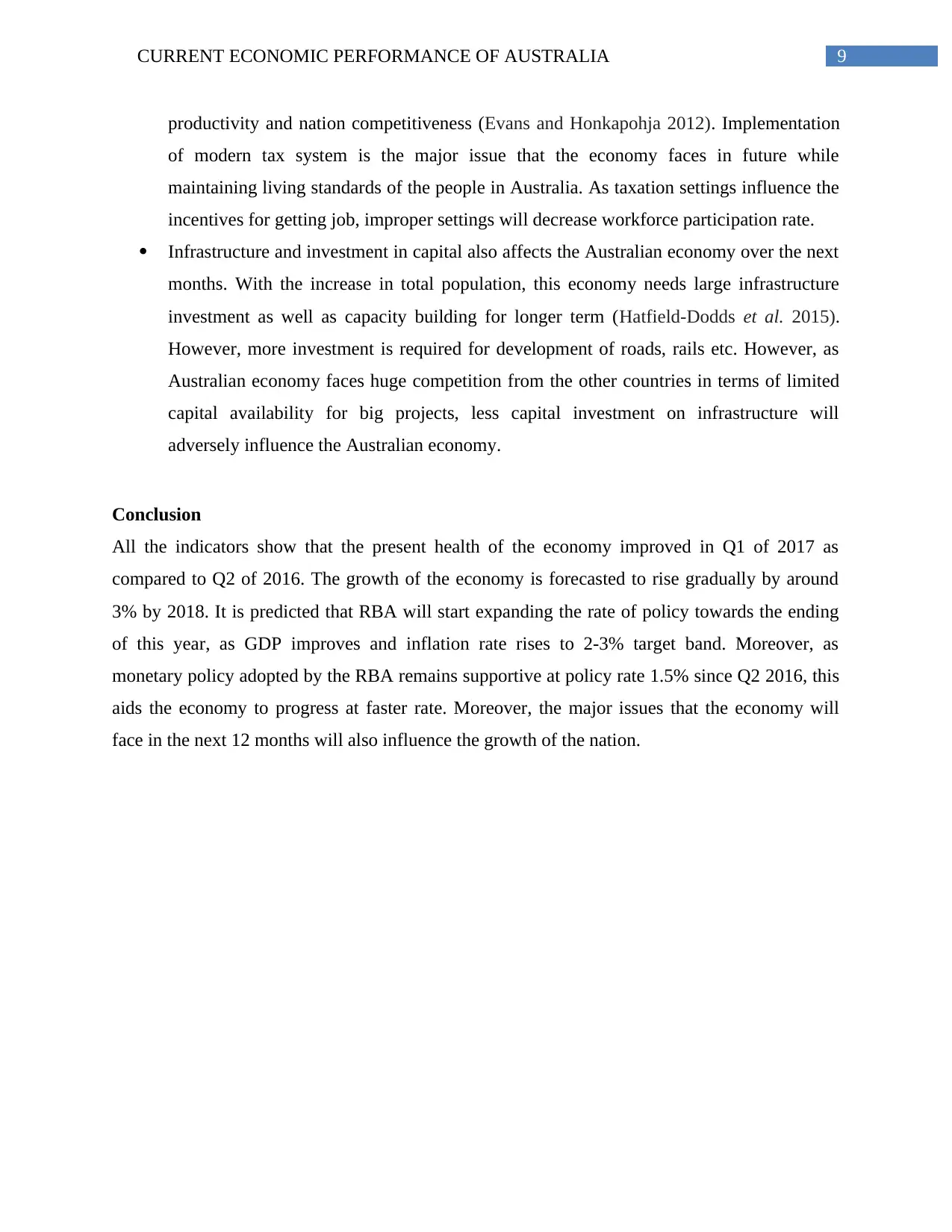
9CURRENT ECONOMIC PERFORMANCE OF AUSTRALIA
productivity and nation competitiveness (Evans and Honkapohja 2012). Implementation
of modern tax system is the major issue that the economy faces in future while
maintaining living standards of the people in Australia. As taxation settings influence the
incentives for getting job, improper settings will decrease workforce participation rate.
Infrastructure and investment in capital also affects the Australian economy over the next
months. With the increase in total population, this economy needs large infrastructure
investment as well as capacity building for longer term (Hatfield-Dodds et al. 2015).
However, more investment is required for development of roads, rails etc. However, as
Australian economy faces huge competition from the other countries in terms of limited
capital availability for big projects, less capital investment on infrastructure will
adversely influence the Australian economy.
Conclusion
All the indicators show that the present health of the economy improved in Q1 of 2017 as
compared to Q2 of 2016. The growth of the economy is forecasted to rise gradually by around
3% by 2018. It is predicted that RBA will start expanding the rate of policy towards the ending
of this year, as GDP improves and inflation rate rises to 2-3% target band. Moreover, as
monetary policy adopted by the RBA remains supportive at policy rate 1.5% since Q2 2016, this
aids the economy to progress at faster rate. Moreover, the major issues that the economy will
face in the next 12 months will also influence the growth of the nation.
productivity and nation competitiveness (Evans and Honkapohja 2012). Implementation
of modern tax system is the major issue that the economy faces in future while
maintaining living standards of the people in Australia. As taxation settings influence the
incentives for getting job, improper settings will decrease workforce participation rate.
Infrastructure and investment in capital also affects the Australian economy over the next
months. With the increase in total population, this economy needs large infrastructure
investment as well as capacity building for longer term (Hatfield-Dodds et al. 2015).
However, more investment is required for development of roads, rails etc. However, as
Australian economy faces huge competition from the other countries in terms of limited
capital availability for big projects, less capital investment on infrastructure will
adversely influence the Australian economy.
Conclusion
All the indicators show that the present health of the economy improved in Q1 of 2017 as
compared to Q2 of 2016. The growth of the economy is forecasted to rise gradually by around
3% by 2018. It is predicted that RBA will start expanding the rate of policy towards the ending
of this year, as GDP improves and inflation rate rises to 2-3% target band. Moreover, as
monetary policy adopted by the RBA remains supportive at policy rate 1.5% since Q2 2016, this
aids the economy to progress at faster rate. Moreover, the major issues that the economy will
face in the next 12 months will also influence the growth of the nation.
Paraphrase This Document
Need a fresh take? Get an instant paraphrase of this document with our AI Paraphraser
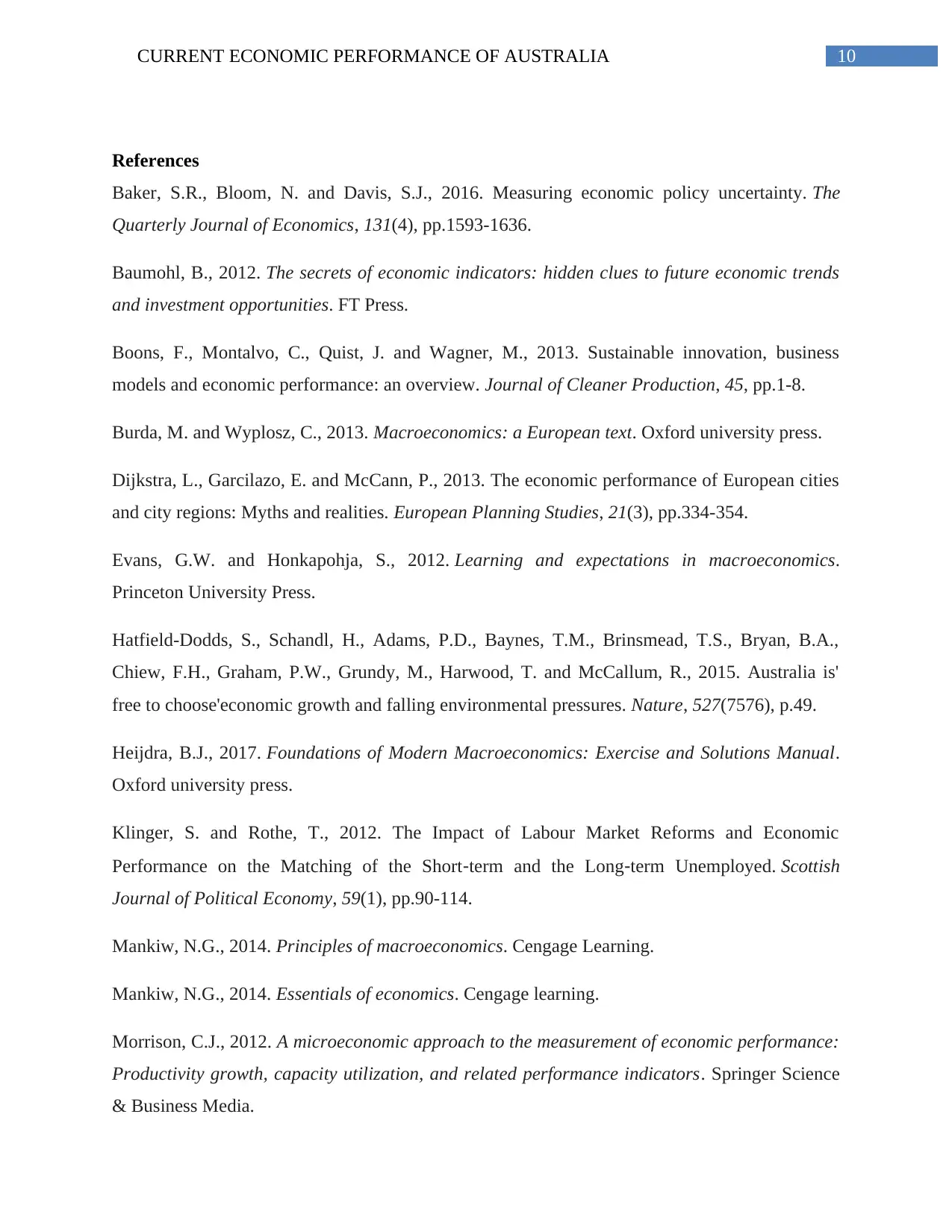
10CURRENT ECONOMIC PERFORMANCE OF AUSTRALIA
References
Baker, S.R., Bloom, N. and Davis, S.J., 2016. Measuring economic policy uncertainty. The
Quarterly Journal of Economics, 131(4), pp.1593-1636.
Baumohl, B., 2012. The secrets of economic indicators: hidden clues to future economic trends
and investment opportunities. FT Press.
Boons, F., Montalvo, C., Quist, J. and Wagner, M., 2013. Sustainable innovation, business
models and economic performance: an overview. Journal of Cleaner Production, 45, pp.1-8.
Burda, M. and Wyplosz, C., 2013. Macroeconomics: a European text. Oxford university press.
Dijkstra, L., Garcilazo, E. and McCann, P., 2013. The economic performance of European cities
and city regions: Myths and realities. European Planning Studies, 21(3), pp.334-354.
Evans, G.W. and Honkapohja, S., 2012. Learning and expectations in macroeconomics.
Princeton University Press.
Hatfield-Dodds, S., Schandl, H., Adams, P.D., Baynes, T.M., Brinsmead, T.S., Bryan, B.A.,
Chiew, F.H., Graham, P.W., Grundy, M., Harwood, T. and McCallum, R., 2015. Australia is'
free to choose'economic growth and falling environmental pressures. Nature, 527(7576), p.49.
Heijdra, B.J., 2017. Foundations of Modern Macroeconomics: Exercise and Solutions Manual.
Oxford university press.
Klinger, S. and Rothe, T., 2012. The Impact of Labour Market Reforms and Economic
Performance on the Matching of the Short‐term and the Long‐term Unemployed. Scottish
Journal of Political Economy, 59(1), pp.90-114.
Mankiw, N.G., 2014. Principles of macroeconomics. Cengage Learning.
Mankiw, N.G., 2014. Essentials of economics. Cengage learning.
Morrison, C.J., 2012. A microeconomic approach to the measurement of economic performance:
Productivity growth, capacity utilization, and related performance indicators. Springer Science
& Business Media.
References
Baker, S.R., Bloom, N. and Davis, S.J., 2016. Measuring economic policy uncertainty. The
Quarterly Journal of Economics, 131(4), pp.1593-1636.
Baumohl, B., 2012. The secrets of economic indicators: hidden clues to future economic trends
and investment opportunities. FT Press.
Boons, F., Montalvo, C., Quist, J. and Wagner, M., 2013. Sustainable innovation, business
models and economic performance: an overview. Journal of Cleaner Production, 45, pp.1-8.
Burda, M. and Wyplosz, C., 2013. Macroeconomics: a European text. Oxford university press.
Dijkstra, L., Garcilazo, E. and McCann, P., 2013. The economic performance of European cities
and city regions: Myths and realities. European Planning Studies, 21(3), pp.334-354.
Evans, G.W. and Honkapohja, S., 2012. Learning and expectations in macroeconomics.
Princeton University Press.
Hatfield-Dodds, S., Schandl, H., Adams, P.D., Baynes, T.M., Brinsmead, T.S., Bryan, B.A.,
Chiew, F.H., Graham, P.W., Grundy, M., Harwood, T. and McCallum, R., 2015. Australia is'
free to choose'economic growth and falling environmental pressures. Nature, 527(7576), p.49.
Heijdra, B.J., 2017. Foundations of Modern Macroeconomics: Exercise and Solutions Manual.
Oxford university press.
Klinger, S. and Rothe, T., 2012. The Impact of Labour Market Reforms and Economic
Performance on the Matching of the Short‐term and the Long‐term Unemployed. Scottish
Journal of Political Economy, 59(1), pp.90-114.
Mankiw, N.G., 2014. Principles of macroeconomics. Cengage Learning.
Mankiw, N.G., 2014. Essentials of economics. Cengage learning.
Morrison, C.J., 2012. A microeconomic approach to the measurement of economic performance:
Productivity growth, capacity utilization, and related performance indicators. Springer Science
& Business Media.
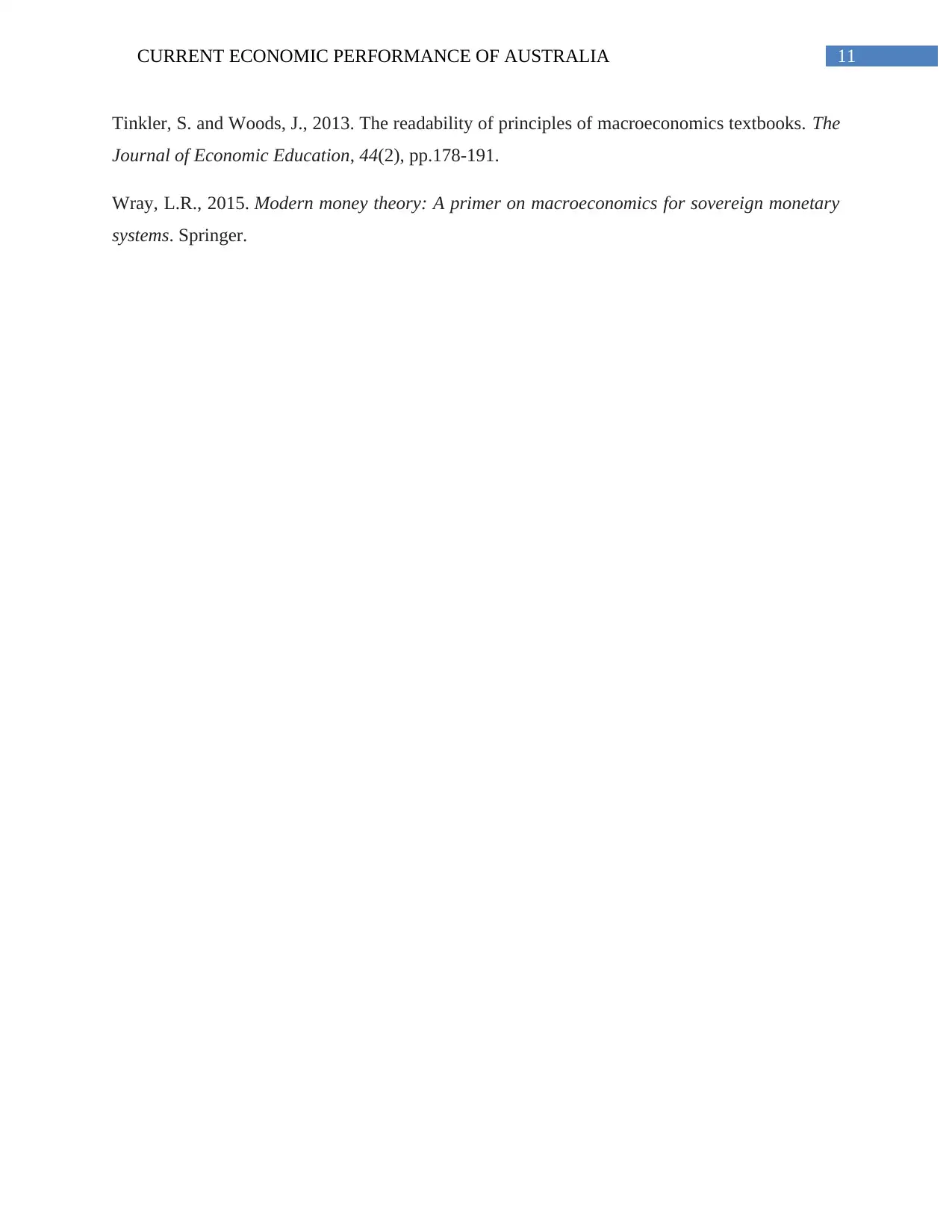
11CURRENT ECONOMIC PERFORMANCE OF AUSTRALIA
Tinkler, S. and Woods, J., 2013. The readability of principles of macroeconomics textbooks. The
Journal of Economic Education, 44(2), pp.178-191.
Wray, L.R., 2015. Modern money theory: A primer on macroeconomics for sovereign monetary
systems. Springer.
Tinkler, S. and Woods, J., 2013. The readability of principles of macroeconomics textbooks. The
Journal of Economic Education, 44(2), pp.178-191.
Wray, L.R., 2015. Modern money theory: A primer on macroeconomics for sovereign monetary
systems. Springer.
⊘ This is a preview!⊘
Do you want full access?
Subscribe today to unlock all pages.

Trusted by 1+ million students worldwide
1 out of 12
Related Documents
Your All-in-One AI-Powered Toolkit for Academic Success.
+13062052269
info@desklib.com
Available 24*7 on WhatsApp / Email
![[object Object]](/_next/static/media/star-bottom.7253800d.svg)
Unlock your academic potential
Copyright © 2020–2025 A2Z Services. All Rights Reserved. Developed and managed by ZUCOL.




